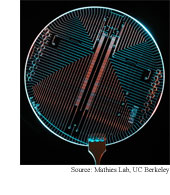|
NEWS
|
DNA sequencer on a chip
 A
DNA-sequencing
biochip that is just 10 centimeters in diameter promises
to make it economically feasible to sequence an individual's
DNA. DNA sequencers are used study disease and develop
drugs, but until now have required bulky and expensive
laboratory equipment. (Microfabricated bioprocessor for
integrated nanoliter-scale Sanger DNA sequencing, Proceedings
of the National Academy of Sciences, published online
April 24, 2006) A
DNA-sequencing
biochip that is just 10 centimeters in diameter promises
to make it economically feasible to sequence an individual's
DNA. DNA sequencers are used study disease and develop
drugs, but until now have required bulky and expensive
laboratory equipment. (Microfabricated bioprocessor for
integrated nanoliter-scale Sanger DNA sequencing, Proceedings
of the National Academy of Sciences, published online
April 24, 2006)
Digital photo CSI
Like scratches on a bullet, the interference
patterns lurking in digital photographs have been
used to link an image to the camera that took it. A mathematical
analysis technique for connecting cameras to images could
extend criminal forensics to the realm of digital photography.
(Determining Digital Image Origin Using Sensor Imperfections,
Image and Video Communications and Processing 2005, San
Jose, January 16-20, 2005)
Liquid disk drive
A photochemical process makes it possible to store
images or data in a liquid. The technique could be
used to make chemical computers capable of storing large
amounts of data. (A Reaction-Diffusion Memory Device,
Angewandte Chemie International Edition, published
online March 29, 2006)
3D Petrie dish
Suspending
cells in a three-dimensional gel makes it possible
to study cells in more lifelike conditions. The technique
could be used for biological research and for developing
methods of growing tissue, including organs. (Probing
the Role of Multicellular Organization in Three-dimensional
Microenvironments, Nature Methods, May, 2006)
Cellular barcodes
Dyeing
cells so that they form fluorescent barcodes makes
it possible to sort cells that come from different sources
in the same container. The technique promises to lower
the cost and time of analyzing cells for medical tests
and developing drugs. (Fluorescent Cell Barcoding in Flow
Cytometry Allows High-Throughput Drug Screening and Signaling
Profiling, Nature Methods, May, 2006)
Superconductor logic
A simple logic circuit made from superconducting
material stores
data in magnetic flow in the circuit. The prototype
flip-flop gate opens the possibility of building very
high speed, low-power computer chips and could be used
to make quantum computers. (Flip-Flopping Fractional Flux
Quanta, Science, published online April 20, 2006)
|
FEATURES
|
View
from the High Ground: Cornell's Jon Kleinberg
Six degrees of separation, buying gasoline
by the molecule, the science of popularity, all just getting
along online, intellectual prosthetics, Big Science, making
up questions, and telling stories.
|
How
It Works: Quantum computing: qubits
Photons, electrons and atoms, oh my! These particles are
the raw materials for qubits, the basic building blocks
of quantum computers. |
|
 |
News RSS feed 
Blog RSS feed 
Bookshelf RSS feed

New: TRN's
Internet Services
TRN's Jobs Center
|
| |
| RESEARCH
WATCH |
| April
12, 2006 |
Toward
implantable sensors
Highlights from the Body Sensor Networks 2006
workshop at MIT last week:
A
computer vision system from the MIT Media
Lab uses tiny wearable cameras to read facial
expressions in order to determine if someone
is paying attention, bored, confused, in disagreement,
or concentrating. The researchers are working
with an autism center to use the system as
a "social-emotional prosthetic"
to help people with autism communicate...
April 5, 2006
Kurzweil
keynote
March
16, 2006
DNA
nanotech made easy
March
12, 2006
Loneliness
trumps exercise |
|
|
| |
|
| |
"In
most areas of science and technology, the origins
of new breakthroughs can still be found in the work
of a small number of people -- or even a single
person -- working at their own pace on their own
questions, pursuing things that interest them. "
- Jon Kleinberg, Cornell University |
|
| |
|
| |
Thanks
to Kevin from
GoldBamboo.com
for technical support |
|

